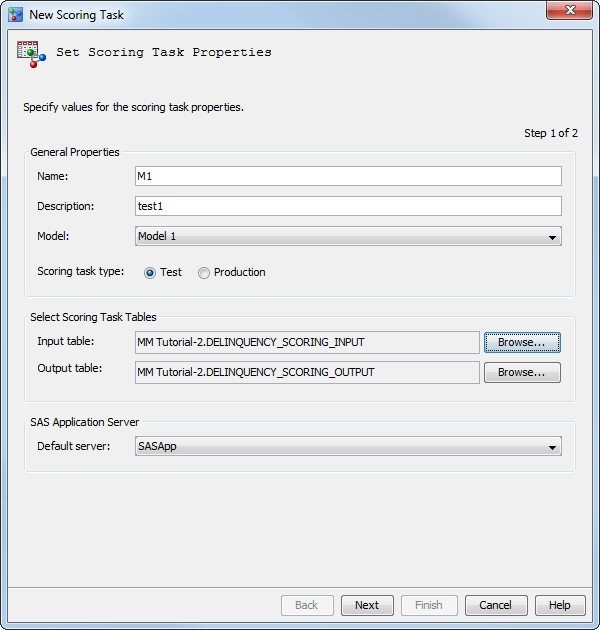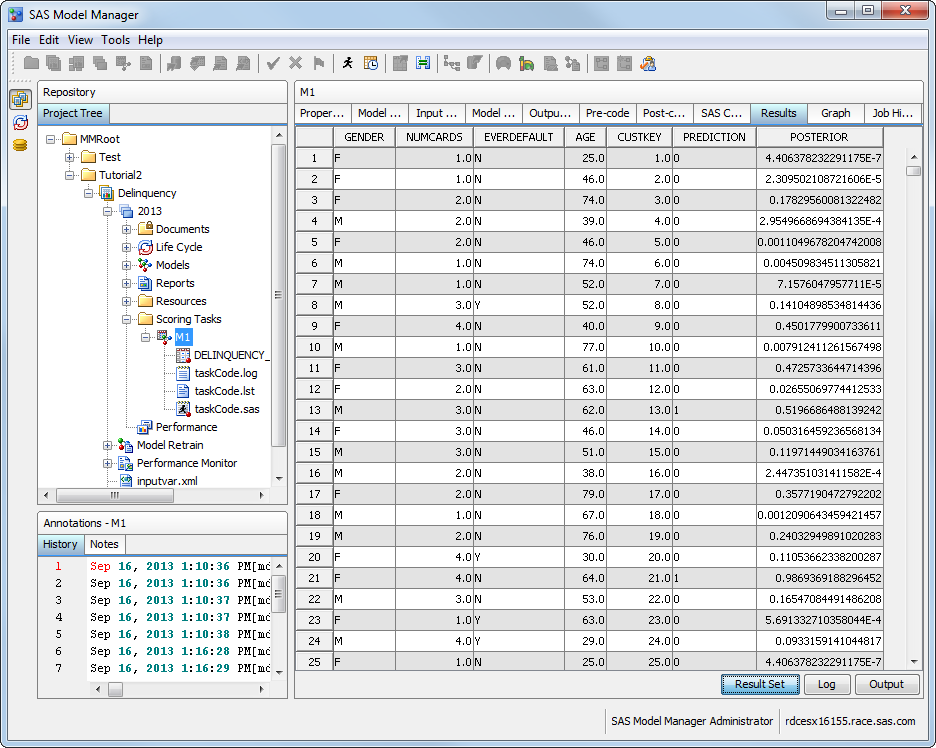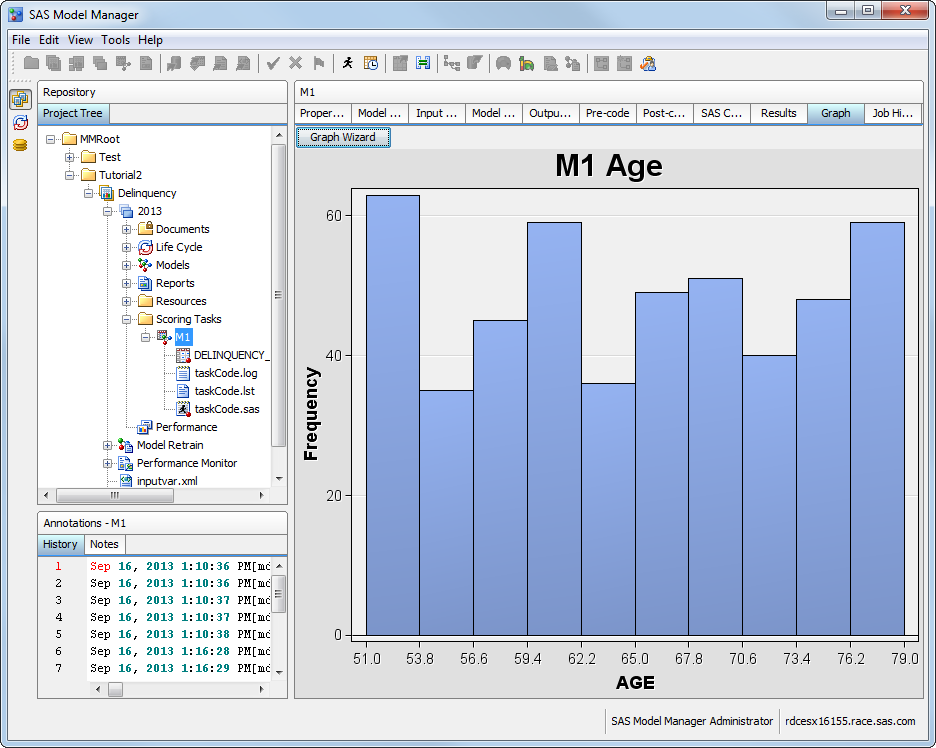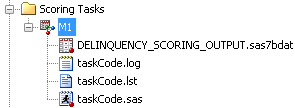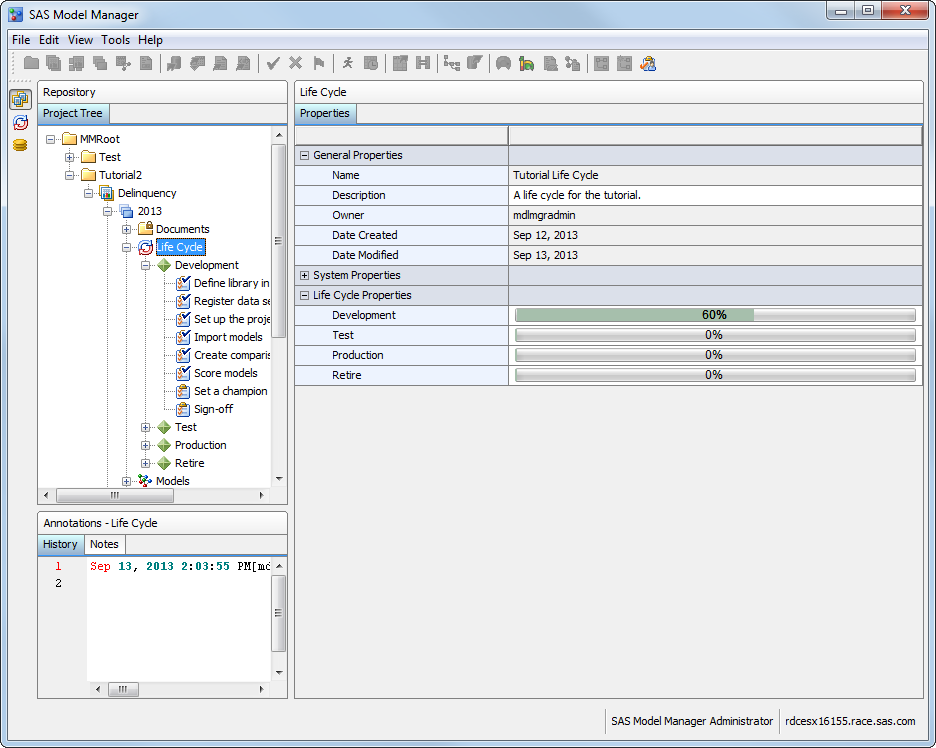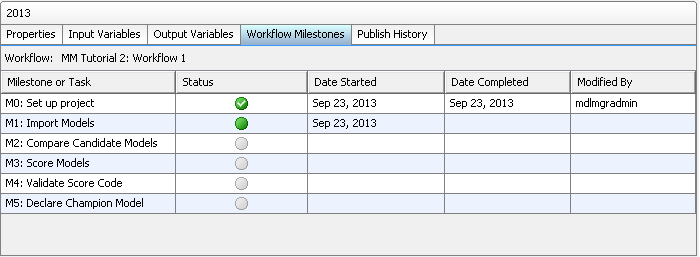Scoring Models
In this exercise, you create a scoring task that is
used to run the score code of a model and produce scoring results.
You use the results to determine the scoring accuracy and to analyze
the model performance. The scoring task uses data from a scoring task
input table, and then generates the results in a scoring task output
table.
Create a Scoring Task
-
Expand the
2013 version,
right-click the
Scoring Tasks folder and
select
New Scoring Task. The
New
Scoring Task wizard appears.
-
Specify the following
options and click
Next:
Name
enter M1 for
the scoring task name.
Model
select Model
1. This model controls the available values for the
input and output tables.
Scoring task type
select Test.
Tip
A best practice is to start
all scoring tasks with
Test selected. When
a scoring task is run as type
Test, the
results are not overwritten. You can change the type to
Production after
you are satisfied with the scoring task results and when the model
is ready for production.
-
Verify that the output
variables are mapped to the model variables. The variable mapping
is as follows:
-
Select the
M1 scoring
task to examine its properties. The value for
Date Modified is
today's date. To change the scoring task name or model input and output
tables, you must create a new scoring task.
Execute a Scoring Task
-
-
Validate the input variables.
Expand the
Scoring Tasks folder, select the
M1 scoring
task and click the

toolbar button. Examine the results of
Quick
Mapping Check, and then click
OK.
-
Right-click the
M1 scoring
task and select
Execute.
-
When the information
dialog box confirms that the report was created successfully, click
Close.
To view the results, click the
Results tab
and click
Result Set.
If the scoring task
was not successful, then review the
Log tab
for error messages.
-
Click the
Graph tab
to graph the results.
-
Click
Graph
Wizard, select
Histogram, and
then click
Next.
-
In the upper right corner,
click
Use default assignments and then click
Next.
-
Click the
Column
name box and select
AGE.
-
Click the
Operator box
and select
Greater than.
-
In the
Value field,
enter
50. Click
Next.
-
In the
Title field
of the
Chart Titles page, type
M1
Age. Click
Next and then
click
Finish.
Here is the histogram
on the
Results tab:
-
Expand the
M1 scoring
task to verify that four content files were saved and that the value
for
Date Modified is today's date.
Here is the
Scoring
Tasks folder and the files for the
M1 scoring
task:
Update the Life Cycle (Optional)
To update the Development
milestone:
-
In the
Delinquency project,
expand
2013 Life Cycle
Life Cycle Development
Development.
-
Select the
Score
models task. Click the
Status box
and select
Completed.
-
Select
Score
models. The
Completed Date and
Completed
By fields have been updated with today's date and your
user ID.
-
Click the
Life
Cycle node to examine its properties. The value for
Modification
Date is today's date. The
Development property
displays a bar chart that shows the percentage of completed tasks
for this milestone.
Update the Workflow Process (Optional)
To complete the activities
in the associated workflow:
-
Select
Tools My Workflow Inbox
My Workflow Inbox or click

from the SAS Model Manager main window to view the
workflow activities in your workflow inbox. Workflow Console is launched
in a web browser, and displays the Activities category view.
Note: The list displays only the
activities for which you are the actual owner or are assigned as a
potential owner, and that have the state of
Started.
-
From the
Activities category
view, select an activity name, and click

.
Note: You can select an activity
name and click

to release an activity that you had previously claimed.
-
(Optional) Enter a property
value or change an existing property value in the
Properties pane.
-
(Optional) Double-click
an activity to view the activity details. From the activity details
view, you can modify activity properties or perform the model management
tasks that are associated with the activity.
Note: If you did not claim the
activity from the Activities category view, you can select the
Claim check
box in the activity status bar.
-
(Optional) Add a comment
to the activity using the
Comments pane.
-
Select a status value
to complete the activity. The workflow continues to the next activity.
-
Repeat steps 2 through
6 for the activities that you completed during this tutorial.
Note: A workflow can be configured
to display the activities that are associated with a milestone or
task on the
Workflow Milestones tab and in
the Workflow Milestones report for a version in the SAS Model Manager
client application. From the
Workflow Milestones tab,
you can view the status of milestones or tasks that are associated
with activities in the workflow.
Copyright © SAS Institute Inc. All rights reserved.
